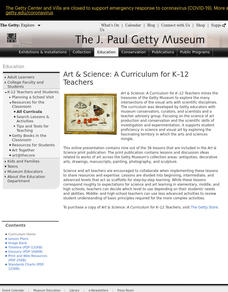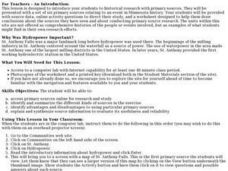Curated OER
Art Exposes
Students view examples of art forms of specific artists. They choose one artist from the country they are studying and present information along with a slide show. Studenys create their own work of art in the style of their chosen...
Curated OER
Physical Health
Students discover and identify how germs are spread, the diseases they can cause, and how hand washing can help prevent the spread of germs. They learn about some of the health habits that are essential for maintaining good health.
Curated OER
Print Advertising: Past and Present
Twelfth graders identify the way advertisements are constructed to influence out lives and our values. They review advertisements from the 1800s and 1900s and how they may have influenced people living in that time. Using this ad, 12th...
Curated OER
What Can I Do?
Students identify feelings and learn how to handle conflict. In this character education lesson, discuss what to do when a friend is feeling sad and develop positive ways to handle negative feelings.
Curated OER
A Different Kind of Rock Star
Students examine the mysteries of Mars. In this scientific comprehension lesson, students read a USA Today article and discuss questions about Mars. To conclude the lesson, students engage in a Rorshach inspired experiment.
Curated OER
Symbols of a Life
Students identify the narrative elements in a work of art and write their own narrative. In this narrative and symbolism lesson, students interpret narratives depicted in the given works of art and write a biographical narrative about a...
Curated OER
Vietnam and the Long-Term Effects of War
Students examine the aftermath of war. In this Vietnam War instructional activity, students consider the implications of war as they analyze the image Siege of An Loc, South Vietnam. Students discuss the causes of the war and the...
Curated OER
Clearly Classified
Learners investigate plants and insects. In this science classification lesson plan, young scholars create separate categories for insects and plants by characteristics. Learners discover scientific names of insects.
Curated OER
ESL Holiday Lessons: National Sense of Smell Day
In this language skills worksheet, students read an article about National Sense of Smell Day. Students respond to 6 matching questions, 29 fill in the blank questions, 30 multiple choice questions, 12 word scramble ...
Curated OER
Chocolate Place - Factories around the world
Students create a PowerPoint presentation on how chocolate is made. In this chocolate lesson, students locate chocolate factories around the world, and study the process of converting the cacao seed into a chocolate bar. Students share...
Curated OER
America at the Centennial
Young scholars explore centennial America. For this American history lesson, students search the Library of Congress digital collections for primary sources regarding the lifestyles and values of Americans in 1876. Young scholars design...
Curated OER
Zen and the Design of Homework Desks
Students investigate zen. For this design lesson, students use ideas from zen to create a study area. Students understand how different environments affect work habits. Students research how students in other countries study and write...
Curated OER
Germs Can Make You Sick
Learners explore how germs are spread. In this science lesson, students practice good hand washing practices and discuss how washing hands can prevent the spread of germs.
Curated OER
Smithsonian Research Cuts
Students investigate the Smithsonian research projects of 2001. They complete a Webquest that explores the Smithsonian Institution website, answer discussion questions, and locate newspaper articles about research conducted by the forest...
Curated OER
Mary Ann Patten: Clipper Ship Heroine
In two groups, students research the history and current building of clipper ships. In this inquiry instructional activity, students present information and compare and contrast the technological revolution with the development of...
Curated OER
Inspiring Freedom: The Remond Family and Abolitionism in Salem
Students examine the abolitionist movement in Salem. Exploring the contributions of the Remond family, they identify how they made the issue one of national and international importance. They discuss the views of the south and how...
Curated OER
Learning Empathy Through Art
Students observe the painting, From That Day On, by Ben Shahn, and reflect on the story of the Lucky Dragon. They research and discuss the physical and emotional side effects on the Japanese people after the atomic bomb was dropped.
Curated OER
An Introduction:
Learners explore historical research with primary sources about Hydropower.
Curated OER
History, Literature, Art: Connections
Eleventh graders read either The Death of the Ball Turret Gunner, The Crucible, or Hiroshima, and examine connection between art and literature by relating particular works of art to their readings, relying on both visual and written...
Curated OER
Domains Portrayed and Invaded
Students examine the art and work of Carl Runguis. After reading a play, they discuss how an artist portrays his feelings about a topic in his work. They view the preplay and write an essay reflecting on their experiences. They also...
Curated OER
Exploring Suffragists
Students engage in a conversation with the class about suffrage- the right to vote. They choose one specific suffragist and use the Internet and other reference materials to learn more about this person. They prepare a presentation to...
Curated OER
Shaping Ideas: Symbolism in Sculpture
Students use criteria developed in class to evaluate which of their own sketches would make the best symbolic sculpture. They choose a final design, techniques and materials, and create sculptures based on their designs.
Curated OER
Artistic License
Students consider the venues in which they prefer to view art. They research art institutions' efforts to stimulate and fulfill the public's appetite for art, then compare them with similar efforts by commercial venues.
Curated OER
The Nobel Prize
Young scholars investigate the Nobel Prize winners for 2001. They complete a Webquest, explore various websites, watch a video, answer discussion questions, and identify and read newspaper articles about Nobel Prize categories.

























